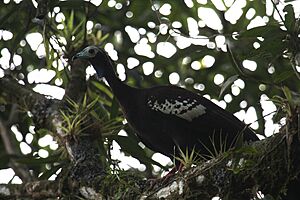Trinidad piping guan facts for kids
Quick facts for kids Trinidad piping guan |
|
|---|---|
 |
|
| Conservation status | |
| Scientific classification | |
| Genus: |
Pipile
|
| Species: |
pipile
|
 |
|
The Trinidad piping guan (Pipile pipile), also called the pawi by local people, is a special type of bird. It belongs to the same bird family as chachalacas, guans, and curassows, called Cracidae. This bird lives only on the island of Trinidad. When a plant or animal lives in just one place, it is called endemic.
This large bird looks a bit like a turkey. Scientists have found that its closest living relative is the blue-throated piping guan from South America. The Trinidad piping guan mostly lives in trees, which means it is an arboreal species. It eats mostly fruit, but also flowers and leaves.
Long ago, there were many of these birds. But their numbers have gone down a lot. They have even disappeared from many places where they used to live. This is called being "extirpated" from an area. Because of this, the International Union for Conservation of Nature has said the bird is "critically endangered". This means it is very close to becoming extinct in the wild.
Contents
What Does the Trinidad Piping Guan Look Like?
This bird is about 60 centimeters (2 feet) long. It looks a lot like a turkey with a thin neck and a small head. Most of its body is black with a shiny purple color.
It has a large crest (a group of feathers on its head) that is blackish with white edges. It also has big white patches on its wings. The skin on its face and the fleshy part under its chin, called a wattle, are blue. Its legs are red.
The Trinidad piping guan makes a thin, piping sound. When it flies, its wings make a whirring noise.
Where Do They Live and What Do They Eat?
These birds live in forests. They build their nests high up in trees. The female bird lays three large white eggs. She sits on the eggs to keep them warm until they hatch. This is called incubating.
Since they are arboreal (tree-dwelling) birds, they find their food in trees. They eat different kinds of fruit and berries. Some examples are the fruit from the fragrant nutmeg tree and the baboonwood tree. They also eat flowers and leaves. Scientists are still studying if small insects are part of their diet.
How Did This Bird Come to Be?
Scientists have studied the Trinidad piping guan's family tree. They found that its closest living relative is the blue-throated piping guan. These two types of birds likely became separate species a very long time ago, possibly as far back as 1.6 million years ago.
Trinidad has only been an island since the end of the last ice age. This means the Trinidad piping guan probably first lived on the mainland of South America. Later, it moved to Trinidad or became limited to the island. There was a report that one of these birds was found near the Orinoco River in Venezuela around 1800. This might mean the bird used to live in Venezuela too, but disappeared from there.
Why Is the Trinidad Piping Guan Endangered?
This bird is found only on the island of Trinidad. It used to be common in the Northern Range and the southern Trinity Hills. It also lived in lowland areas like the Nariva Swamp.
However, the Trinidad piping guan is now in danger. The biggest threats are illegal hunting and, to a smaller extent, the destruction of its habitat. It no longer lives in the lowlands. It is almost certainly gone from the Trinity Hills, where no one has seen it since 1994.
There was a reliable report of a sighting in the Northern Range in 2000. There are still about 200 to 350 square kilometers (77 to 135 square miles) of good habitat left there. Because of these serious threats, the International Union for Conservation of Nature has listed the Trinidad piping guan as "critically endangered". This means it faces an extremely high risk of disappearing from the wild.


